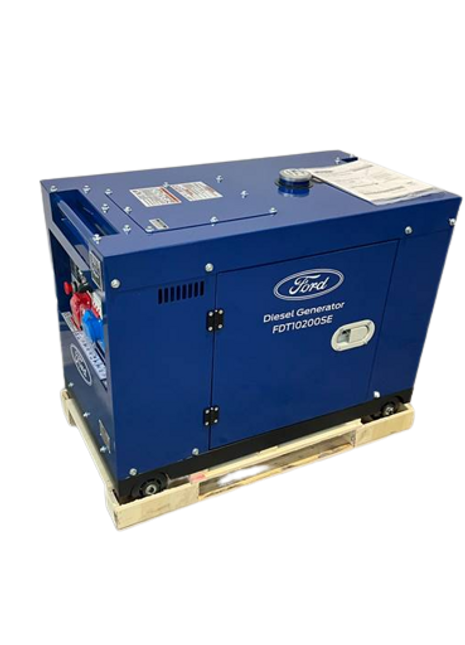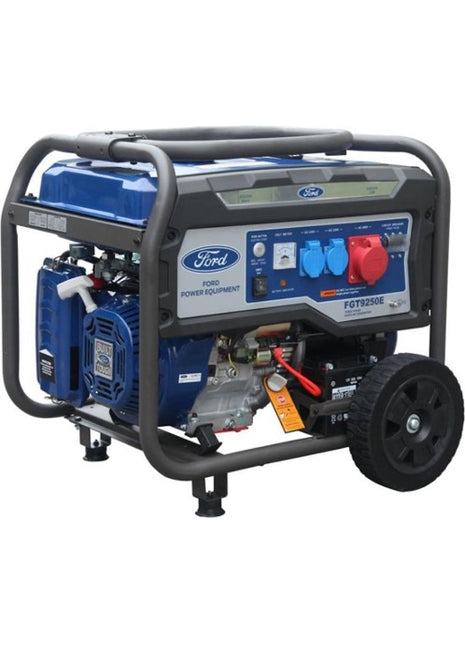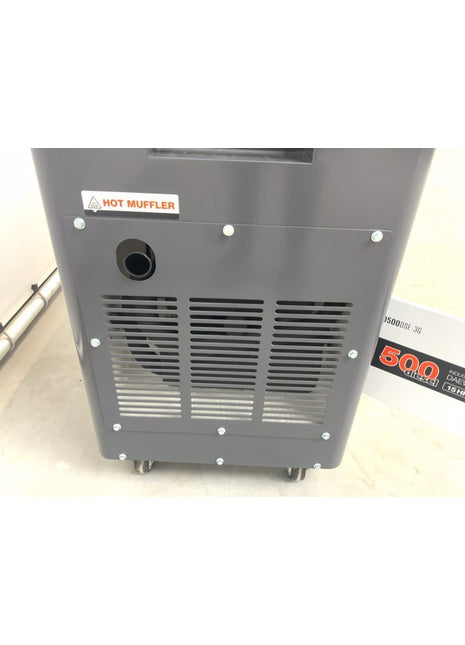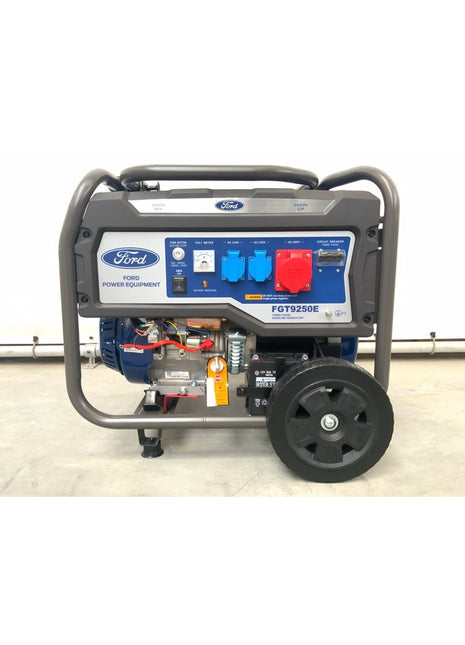Power generators up to 10,000 watts
High-performance power generators up to 10,000 watts are versatile and robust devices that ensure a reliable power supply in a wide range of applications.

High-performance power generators up to 10,000 watts are versatile and robust devices that ensure a reliable power supply in a wide range of applications.


Angeboten wird ein schallgedämpftes, wassergekühltes Dieselaggregat mit einer Leistung von 75 kVA / 60 kW (Dauerleistung) der Marke RTE. Der Stromerzeuger eignet sich ideal für eine netzunabhängige Stromversorgung – z. B. auf Baustellen, bei Veranstaltungen, in Notfallsituationen oder überall dort, wo eine zuverlässige Energiequelle benötigt wird. Im Inneren arbeitet ein robuster Ricardo-Dieselmotor (Motor-Modell: R4105AZLD). Ricardo-Motoren stehen für langlebige, industrielle Qualität und sind auf dauerhaften Einsatz ausgelegt. Der Generator liefert eine Ausgangsspannung von 400 V bei 3-Phasen-Betrieb und einer Frequenz von 50 Hz. Der Nennstrom liegt bei 108,3 A, der Leistungsfaktor bei cos φ = 0,8. Im Stand-by-Betrieb stellt das Aggregat bis zu 83 kVA / 66 kW bereit – ideal für Lastspitzen oder als zuverlässige Notstromquelle. Die Drehzahl beträgt 1500 U/min, wodurch ein stabiler Dauerbetrieb gewährleistet wird. Die Ausführung ist als CONT. (Continuous Rating) ausgelegt – also für den dauerhaften Einsatz. Der Generator wird mit 12 Monaten Garantie geliefert. Ersatzteile sind bei Bedarf jederzeit erhältlich. Es handelt sich um originalverpackte Neuware, die entweder in 47906 Kempen abgeholt oder kostenlos deutschlandweit versendet werden kann. Bei Fragen oder individuellen Anforderungen stehen wir Ihnen jederzeit gerne zur Verfügung – schreiben Sie uns oder rufen Sie uns direkt an. Technische Daten Marke RTE Ausführung Dieselgenerator schallgedämpft Dauerleistung (Rated Output) 75 kVA / 60 kW Stand-by-Leistung 83 kVA / 66 kW Spannung 400 V Phasen 3 Frequenz 50 Hz Nennstrom 108,3 A Leistungsfaktor 0,8 Drehzahl 1500 U/min Betriebsart CONT. (Dauerbetrieb) Motormodell Ricardo R4105AZLD Alternator-Modell 224F Unser Ersatzteilservice – Schnell. Sicher. Zuverlässig. Bei GRAEFER Maschinen erhalten Sie passende Ersatz- und Verschleißteile in der Regel innerhalb von 48 Stunden. Direkt ab Lager – für viele Modelle sofort verfügbar Internationaler Versand über verlässliche Logistikpartner Beratung durch erfahrene Servicetechniker Kurze Reaktionszeiten bei dringendem Bedarf Unser Ziel: Minimale Ausfallzeiten und ein reibungsloser Betrieb Ihrer Maschine. GRAEFER Maschinen ist Ihr Partner für dauerhafte Einsatzfähigkeit und erstklassigen After-Sales-Service. Sie haben Fragen zum Produkt oder benötigen weitere technische Daten? Rufen Sie uns einfach an: +49 2161 9850020
12.499,00€11.999,00€
vAT included.

The Ford FDT10200SE Generator is the ideal choice for anyone who wants a reliable power supply need – be it on Construction sites, in Emergencies or at Outdoor activities. This Diesel generator is equipped with a powerful 4-stroke single-cylinder Hyundai diesel engine with 498 cm³ engine displacement equipped with a maximum output of 7.9 kVA and a continuous output of 7.5 kVA delivers. The device is for a automatic transition switching (ATS) suitable, which allows the The emergency power generator automatically kicks in., as soon as the main power supply fails. Fuel gauge provides reliable information about the current fill level of the 13-liter fuel tanks, which has a duration of up to 7 hours at 75% load and 13 hours at 50% load made possible. The Ford FDT10200SE Generator has a Electric starter, which enables a quick and reliable start of the device. At low oil level The generator switches on automatically off, to avoid possible damage to the engine. With 1 230V (single-phase) socket and 1 socket 400V (3-phase) This generator offers sufficient connection options for a wide variety of applications. compact and robust design enables easy handling and transport. On the Power generator receive 12-month warranty. spare parts can be ordered at any time. The item can be ordered in 47906 Kempen picked up or Shipped at no extra charge will be. It concerns New product – You will receive a Original packaged product. Please feel free to write to us with any further questions or requests, or call us directly. Technical data brand ford type FDT10200SE Exit 230V single-phase &400V 3-phase Motor 4-stroke single-cylinder Hyundai diesel engine Engine displacement 498 cm³ Maximum performance 7.9 kVA Continuous power 7.5 kVA fuel tank 13 liters Duration 7 hours at 75% load/13 hours at 50% load Suitable for ATS Yes Fuel gauge Yes Oil protection Automatic shutdown when oil level is low Electric starter Yes Our spare parts service – Fast. Safe. Reliable. At GRAEFER Maschinen you can usually obtain suitable spare and wear parts. within 48 hours. Direct from stock – many models available immediately International shipping via reliable logistics partners Consultation by experienced service technicians Short response times in urgent cases Our goal: Minimal downtime and smooth operation of your machine.GRAEFER Maschinen is your partner for long-term operational capability and first-class after-sales service. Do you have questions about the product or need further technical data? Just give us a call: +49 2161 9850020
2.499,00€2.299,00€
vAT included.

The Daewoo DDAE10500DSE-3G power generator is a powerful and reliable device for numerous applications. Diesel generator offers a maximum Power output of 8.1 kVA at 400V and 7.3 kVA at 230V as well as a Continuous power output of 7.5 kVA at 400V and 6.7 kVA at 230VWith its two electrical outlets – one 230V single-phase socket and one 400V 3-phase socket – it is flexible in its application and provides power for a wide range of uses. The diesel engine the DDAE10500DSE-3G has 498 cm³ engine displacement and a Power output of 15 hp, which ensures a constant and reliable power supply. With its 15-liter fuel tank and the integrated Fuel gauge Keep an eye on your consumption at all times. Electric starter enables a quick and convenient start. Whether for the operation of Construction machinery, on Construction sites, in the Garden or as Backup power supply - the Daewoo DDAE10500DSE-3G is an excellent choice. robust construction and the high performance making it ideal for professional use, while at the same time offering the flexibility and user-friendliness, which also makes it attractive for private use. On the Power generator receive 12-month warranty. spare parts can be ordered at any time. The item can be ordered in 47906 Kempen picked up or Shipped at no extra charge will be. It concerns New product – You will receive a Original packaged product. Please feel free to write to us with any further questions or requests, or call us directly. Technical data brand Daewoo type DDAE10500DSE-3G Exit 230V single-phase &400V 3-phase Motor Diesel – 498 cm³ displacement, 15 hp Maximum performance 8.1 kVA (400V)/7.3 kVA (230V) Continuous power 7.5 kVA (400V)/6.7 kVA (230V) fuel tank 15 liters battery 36 Ah Fuel gauge Yes Electric starter Yes Our spare parts service – Fast. Safe. Reliable. At GRAEFER Maschinen you can usually obtain suitable spare and wear parts. within 48 hours. Direct from stock – many models available immediately International shipping via reliable logistics partners Consultation by experienced service technicians Short response times in urgent cases Our goal: Minimal downtime and smooth operation of your machine.GRAEFER Maschinen is your partner for long-term operational capability and first-class after-sales service. Do you have questions about the product or need further technical data? Just give us a call: +49 2161 9850020
2.299,00€1.899,00€
vAT included.

The Ford FGT9250E is a powerful and reliable Power generator, which is designed for use in a wide variety of areas. With its two 230V single-phase sockets (IP44 Schuko) and a 400V 3-phase socket (V-CEE 16A) it can supply power to a wide variety of devices and tools. The generator is powered by a 420 cc, 4-stroke, air-cooled petrol engine. The 25-liter fuel tank enables a runtime of up to [duration] under full load 7 hours, with a consumption of approximately 3.5 l/h. The Ford FGT9250E offers extensive security and monitoring features, including a Residual current device, a Voltage meter, one Fuel gauge as well as a Oil spill alertFurthermore, he is with Electric starter and Reverse start equipped to make starting particularly convenient. With its robust construction, simple operation and versatile functions, the Ford FGT9250E the perfect companion for Construction sites, Gardens, at power outages or campsites. On the Power generator receive 12-month warranty. spare parts can be ordered at any time. The item can be ordered in 47906 Kempen picked up or Shipped at no extra charge will be. It concerns New product – You will receive a Original packaged product. Please feel free to write to us with any further questions or requests, or call us directly. Scope of delivery: 1× Ford FGT9250E 3-phase generator, oil funnel, wrench, solid wheels, splitter, screws and nuts for assembly. Technical data brand ford type FGT9250E 3-Phase Exit 2× 230V single-phase &am; 1× 400V 3-phase Fuel type petrol Motor 420 cc/4-stroke/air-cooled fuel tank 25 liters Fuel consumption approx. 3.5 l/h at full load Duration up to 7 hours Residual current device Yes Voltage meter Yes Fuel gauge Yes Oil spill alert Yes Electric starter/Recoil start Yes Our spare parts service – Fast. Safe. Reliable. At GRAEFER Maschinen you can usually obtain suitable spare and wear parts. within 48 hours. Direct from stock – many models available immediately International shipping via reliable logistics partners Consultation by experienced service technicians Short response times in urgent cases Our goal: Minimal downtime and smooth operation of your machine.GRAEFER Maschinen is your partner for long-term operational capability and first-class after-sales service. Do you have questions about the product or need further technical data? Just give us a call: +49 2161 9850020
1.399,00€1.299,00€
vAT included.

The Daewoo GDA2500iS inverter generator It offers an ideal power source for on the go, in the garden, while camping, or as an emergency generator at home. With a Operating power of 2000 W and one Maximum power output of 2200 W This inverter generator provides reliable energy for your electrical devices. Through the Inverter technology It ensures a clean and stable power supply, making it particularly suitable for sensitive electronics such as laptops, smartphones, or tablets. The GDA2500iS is unused and guarantees long-lasting performance. High-performance and stable energy supply The Daewoo GDA2500iS comes with a Operating power of 2,000 W and one Maximum power output of 2,200 W Enough energy to reliably operate various electrical devices. Thanks to the alternating current of 8.7 A The generator is versatile and can be used for everything from operating small tools to powering household appliances. Versatile connectivity options This inverter generator offers versatile connection options, including a 230V socket, a USB output (5V, 1.0A/2.1A) as well as two 12V DC outputs with 8AThis flexibility makes it perfect for charging smartphones, tablets and car batteries, or for powering lights and smaller devices. Compact, portable and easy to use Thanks to its compact design, the Daewoo GDA2500iS is easy to transport and versatile. It is ideal for outdoor activities such as camping or as a backup power supply for home use. With a maximum operating temperature of 40°C and deployment at altitudes of up to 1000 m It is ideal for various environments and climatic conditions. High efficiency and environmental friendliness The Power factor of 1.0 This ensures high generator efficiency, optimizing fuel consumption and reducing environmental impact. The modern Inverter technology This ensures constant voltage regulation, which means the device consumes less energy and at the same time guarantees a longer lifespan for the connected devices. Conclusion: The Daewoo GDA2500iS inverter generator This is the perfect choice for anyone looking for a mobile, efficient, and reliable power source. With its compact size, high performance, and versatile connection options, it's ideal for camping, garden use, or as an emergency generator at home. Its modern inverter technology makes it particularly suitable for sensitive devices and ensures a constant, clean power supply.
659,00€
vAT included.

Our Initial commissioning for power generators up to 10 kVA This service ensures your unit is optimally prepared and delivered ready for operation. Performed by our experienced technicians, this service includes all necessary steps for flawless operation and a long service life for your generator. Scope of services for initial commissioning: ✔ Filling of all operating fluidsOil, coolant and a limited amount of fuel (to avoid hazardous material transport).✔ Function test && load testAll load levels are tested to ensure that the generator operates reliably even under load.✔ Verification of all safety-relevant functionsWe check whether all protective mechanisms are working correctly.✔ Initial commissioning protocolOur technicians document all relevant measurements and test results for your records. After completion of the initial commissioning, your power generator Fully functional and ready for immediate useBenefit from a professional service that minimizes downtime and problems from the outset. Only bookable for newly purchased power generators up to 10kVA from us. Ensure a smooth start – with our initial commissioning service for your power generator!
399,00€
vAT included.
Seit Jahren erfolgreich mit kompetenter Beratung und Service.
Vielfältige Industriemaschinen für jede Anforderung.
Zuverlässiger Versand in alle EU-Länder.




